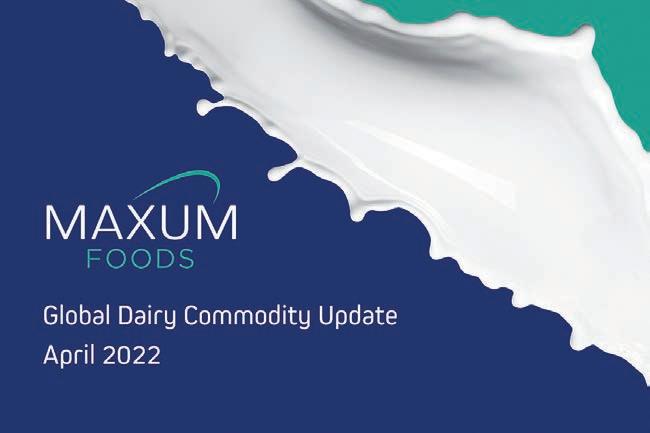
2 minute read
DAIRY
Global dairy commodity update for April 2022
Already tight supplies of milk for fat and protein commodities have been overlaid with complex supply and demand impacts of the Russian invasion of Ukraine and sanctions on Russia and its allies.
Dairy markets are experiencing complex and challenging times.
Global dairy commodity markets will remain under the strong influence of tight EU milk supplies. Product and ingredient prices have been pushed to records in the EU and Oceania which will ration demand and may also eventually see some supply-side response.
US markets are also managing tighter milk supplies while demand recovers from the effects of COVID restrictions, although supply chain challenges continue to drive some price volatility.
While EU milk prices are rising and on-paper margins might appear a little better, high bought-in feed and operating costs and limited fertilizer availability will influence feed availability and milk production.
Weather is hardly supportive in the next year. Europe is forecast to have another hotter than usual spring and summer, and other regions face challenges. The US drought is worsening, while La Nina is weakening in Oceania.
Demand will inevitably be rationed in sensitive consumer markets and segments although little of that is evident yet with the fast ramp up in wholesale prices. This may be compounded in some developing regions that face higher prices in other food staples due to conflict in Ukraine.
Maxum Foods has released their Global Dairy Commodity Update for April.
The world faces higher food and energy costs as a consequence of the Ukraine war which will slow economic growth and eventually affect consumer confidence and spending.
The world market is experiencing unprecedented prices for dairy commodities and products. Milk supply growth in major (top 5) exporting producers weakened to 0.5 per cent in H2-2021, while H1-2022 output will shrink 1.2 per cent.
It comes after dairy leaders called on Woolworths, Aldi, and Coles, to increase the price of milk. eastAUSdairy vice chairman Graham Forbes said Australian shoppers need to now pay two dollars a litre for generic milk in order to keep the sector viable.
He said historically low prices for milk – a hangover from the dollar-a-litre 2010s — were unsustainable.
“Two dollars a litre for milk is still very cheap. You pay more per litre for soft drink or sparkling water,” Mr Forbes said.
“Throughout the dollar-a-litre years, we were always pretty reasonable. We’d say $1.40 a litre or $1.50 a litre was about where the price needed to be.
“But the economy has shifted in the past few months. Inflation is running and the dairy industry needs to keep up, otherwise you’re producing milk for hardly any return.
“Labour costs are high due to worker shortages. Fuel, as we all know, is far more expensive than it was at the start of the year. Two dollars a litre for generic milk is still reasonable in the bigger scheme of things.”
The dollar-a-litre milk push was introduced by Coles and Woolworths in January 2011 and lasted eight years until it rose incrementally to $1.10 a litre. F











